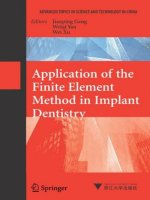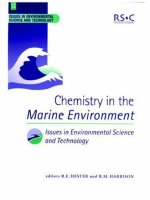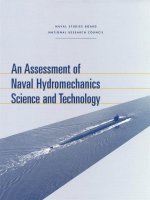APPLICATIONS OF IONIC LIQUIDS IN SCIENCE AND TECHNOLOGY ppt
Bạn đang xem bản rút gọn của tài liệu. Xem và tải ngay bản đầy đủ của tài liệu tại đây (25.41 MB, 528 trang )
APPLICATIONS OF IONIC
LIQUIDS IN SCIENCE
AND TECHNOLOGY
Edited by Scott T. Handy
Applications of Ionic Liquids in Science and Technology
Edited by Scott T. Handy
Published by InTech
Janeza Trdine 9, 51000 Rijeka, Croatia
Copyright © 2011 InTech
All chapters are Open Access articles distributed under the Creative Commons
Non Commercial Share Alike Attribution 3.0 license, which permits to copy,
distribute, transmit, and adapt the work in any medium, so long as the original
work is properly cited. After this work has been published by InTech, authors
have the right to republish it, in whole or part, in any publication of which they
are the author, and to make other personal use of the work. Any republication,
referencing or personal use of the work must explicitly identify the original source.
Statements and opinions expressed in the chapters are these of the individual contributors
and not necessarily those of the editors or publisher. No responsibility is accepted
for the accuracy of information contained in the published articles. The publisher
assumes no responsibility for any damage or injury to persons or property arising out
of the use of any materials, instructions, methods or ideas contained in the book.
Publishing Process Manager Alenka Urbancic
Technical Editor Teodora Smiljanic
Cover Designer Jan Hyrat
Image Copyright Olivier Le Queinec, 2010. Used under license from Shutterstock.com
First published September, 2011
Printed in Croatia
A free online edition of this book is available at www.intechopen.com
Additional hard copies can be obtained from
Applications of Ionic Liquids in Science and Technology, Edited by Scott T. Handy
p. cm.
ISBN 978-953-307-605-8
free online editions of InTech
Books and Journals can be found at
www.intechopen.com
Contents
Preface IX
Part 1 Biomass Utilization 1
Chapter 1 Ionic Liquids in Catalytic Biomass Transformation 3
Zhu Yinghuai, Algin Oh Biying, Xiao Siwei,
Narayan S Hosmane and John A. Maguire
Chapter 2 Biotransformation of Underutilized Natural
Resource to Valuable Compounds in Ionic
Liquid: Enzymatic Synthesis of Caffeic Acid
Phenethyl Ester Analogues from Immature Coffee Beans 27
Atsushi Kurata, Tokio Fujita, and Noriaki Kishimoto
Part 2 Electronic Applications 45
Chapter 3 Undeniable Contribution of Aprotic Room Temperature
Ionic Liquids in the Security of Li-Ion Batteries 47
Claude-Montigny Bénédicte, Stefan Claudia Simona
and Violleau David
Chapter 4 Ionic Liquids in Charge Storage Devices:
Effect of Purification on Performance 73
John D. Stenger-Smith, Andrew P. Chafin, Clare F. Kline Jr.,
Gregory S. Ostrom and Roxanne L. Quintana
Chapter 5 Polymers with Ionic Liquid Fragments as Potential
Conducting Materials for Advanced Applications 83
Santiago V. Luis, Eduardo García-Verdugo, M. Isabel Burguete,
Andreu Andrio, Sergio Mollá and Vicente Compan
Chapter 6 Ionic Liquids for the Electric
Double Layer Capacitor Applications 109
Takaya Sato, Shoko Marukane and Takashi Morinaga
Chapter 7 Ionic Liquid Used in Long-Lifetime
Polymer Light-Emitting Electrochemical Cells 135
Yan Shao
VI Contents
Part 3 Polymers 153
Chapter 8 Ionic Liquids Gelation with
Polymeric Materials: The Ion Jelly Approach 155
Nuno M.T. Lourenço, Ana V.M. Nunes,
Catarina M.M. Duarte and Pedro Vidinha
Chapter 9 Environmentally Friendly Synthesis
of Polymer-Grafted Nanoparticles 173
Norio Tsubokawa
Chapter 10 Ionic Liquids as Porogens
in the Synthesis of Molecularly Imprinted Polymers 197
Katherine M Booker, Clovia I Holdsworth,
Michael C Bowyer and Adam McCluskey
Chapter 11 Magnetorheological
Elastomers Containing Ionic Liquids 213
Marcin Masłowski and Marian Zaborski
Part 4 Nanomaterials and Metals 233
Chapter 12 Concepts for the Stabilization of
Metal Nanoparticles in Ionic Liquids 235
Alexander Kraynov and Thomas E. Müller
Chapter 13 Studies Regarding the Nickel Electrodeposition
from Choline Chloride Based Ionic Liquids 261
Liana Anicai, Andreea Florea and Teodor Visan
Chapter 14 Ionic Liquids as Advantageous
Solvents for Preparation of Nanostructures 287
Alexandrina Nan and Jürgen Liebscher
Part 5 Separation Methods 309
Chapter 15 Ionic Liquids in Separation Techniques 311
Jolanta Flieger and Anna Czajkowska-Żelazko
Chapter 16 Ionic Liquid-Mediated Liquid-Liquid Extraction 343
Qilong Ren, Qiwei Yang, Yan Yan, Huabin Xing,
Zongbi Bao, Baogen Su and Yiwen Yang
Chapter 17 Liquid Matrices in MALDI-MS 361
Yuko Fukuyama
Chapter 18 Ionic Liquids in Separation of
Metal Ions from Aqueous Solutions 375
Magdalena Regel-Rosocka and Maciej Wisniewski
Contents VII
Part 6 Miscellaneous Applications 399
Chapter 19 Inner Filter Effect in the Fluorescence Emission Spectra
of Room Temperature Ionic Liquids with-β-Carotene 401
Krzysztof Pawlak, Andrzej Skrzypczak and Grazyna E. Bialek-Bylka
Chapter 20 Ionic Liquid Lubricant with
Ammonium Salts for Magnetic Media 421
Hirofumi Kondo
Chapter 21 Application of Ionic Liquids to Space Propulsion 447
Fahrat Kamal, Batonneau Yann, Brahmi Rachid
and Kappenstein Charles
Chapter 22 The Latent Application of
Ionic Liquids in Absorption Refrigeration 467
Shiqiang Liang, Wei Chen, Keyong Cheng,
Yongxian Guo and Xiaohong Gui
Chapter 23 Optofluidic Compound Lenses Made with Ionic Liquids 495
Sergio Calixto, Martha Rosete-Aguilar, Francisco J. Sanchez-Marin,
Olga L. Torres-Rocha, E. Militza Martinez Prado
and Margarita Calixto-Solano
Preface
Ionic liquids (more specifically, room temperature ionic liquids (RTIL)) have attracted
considerable interest over the last several years. Although the specific definition of
what is a RTIL varies from person to person, the most generally accepted definition is
a salt with a melting point below 100 °C. Such a broad definition leaves considerable
room for flexibility, which contributed to labeling RTILs as “designer solvents.”
The history of ionic liquids (and the closely related molten salts) has a rather ill-
defined beginning, although it is most commonly dated back to 1914 from the work of
Walden on the use of alkylammonium nitrates. The next burst of interest occurred
with the discovery of chloroaluminates formed by combining quaternary heterocyclic
cations with aluminum chloride. These materials exhibited a great deal of potential for
use in a variety of areas, but all suffered from extreme sensitivity to moisture.
A major step forward was made by Wilkes in the early 1990s, with the report of
moisture stable ionic liquids created by replacing the aluminum chloride with other
anions, such as tetrafluoroborate or hexafluorophosphate. Since that seminal report by
Wilkes and co-workers, the family of RTILs has seen explosive growth. Starting with
imidazolium cations, the cationic component has been varied to include pyridinium,
ammonium, phosphonium, thiazolium, and triazolium species.
In general, these cations have been combined with weakly coordinating anions,
although not all weakly coordinating anions result in RTILs (for example, the very
weakly coordinating polyhedral borane anions of Reed afford salts with melting
points between 45 and 156 °C for a series of imidazolium cations). Common examples
include tetrafluoroborate, hexafluorophosphate, triflate, triflimide, and dicyanimide.
Of these, the first two have been explored the most extensively, and must be treated
with the greatest caution, as they are fairly readily hydrolyzed to boric acid and
phosphate respectively. Indeed, various phosphate and phosphinate anions have been
employed to some advantage in RTILs and the list of possible anionic components
continues to grow at a rapid rate.
This volume, which is the second in a two volume set on ionic liquids, focuses on
applications of ionic liquids in a growing range of areas. Throughout the 1990s, it
seemed that the most attention in the area of ionic liquids applications was directed
toward their use as solvents for organic and transition-metal-catalyzed reactions. This
X Preface
interest certainly continues to the present date, and is touched on in several chapters in
volume 1 of the book, but the most innovative uses of ionic liquids span a much more
diverse field than just synthesis.
Fig. 1. Representative Ionic Liquid Components
For example, since ionic liquids are ions, they have been explored for use in various
electronic applications, including electrolytes for batteries (Claude-Montigny, Stefan,
and Violleau), capacitors and charge storage devices (Takaya, Shoko, and Takashi;
Stenger-Smith, Chafin, Kline, Ostrom, and Quintana), as well as conducting and light
emitting materials (Shao; and Luius, Garci-Verdugo, Burguete, Andrio, Molla, and
Compañ).
There is also a list of ways to employ ionic liquids in the area of polymers: as grafted
components (Maslowski and Zaborski), as solvents for polymerization (Tsubokawa),
as modifiers of polymer morphology (Booker, Holdsworth, Bowyer, and McCluskey),
and even as unusual components of polymers (Vidinha, Lourenco, Nunes, Duarte, and
Barreiros). Similarly, ionic liquids are finding increasing use in the popular area of
nanomaterials.
Much of this effort is directed toward using ionic liquids as either solvents for the
synthesis of nanomaterials (Nan and Liebscher) or their stabilization (Kraynov and
Mueller). Electrodeposition and recovery of metals is a related and fairly mature field
(Anicai, Florea, and Visan).
A second, more mature area of application for ionic liquids is in the field of
separations and spectroscopy (Flieger and Czajkowska-Belazko). For some time, ionic
liquids have been explored as matrices for mass spectrometry (MALDI) (Fukuyama).
Cation
Anion
N
N
N
R
R
R
4
N
R
4
P
BF
4
PF
6
N(CN)
2
NTf
2
Preface XI
In addition to that, they have also been employed in liquid-liquid extraction (Yang,
Xing, Yan, Bao, Su, Yang, and Ren), particularly for recovery of metal salts (Regel-
Rosocka and Wisniewski).
Beyond these main areas of interest though, RTILs are finding their way into many
other fields. One of timely international interest is utilization of biomass as non-
petroleum-based fuels and as bio-renewable specialty chemicals (Kurata, Fujita, and
Kishimoto; Hosmane).
Additional unusual applications are also displayed in this volume, including
spectroscopy (Pawlak, Skrzypczak, and Bialek-Bylka), optical materials (Calixto,
Rosete-Aguilar, Sanchez-Marin, Torres-Rocha, Prado, and Calixto-Solano), lubricants
(Kondo), fuels for propulsion (Fahrat, Batonneau, Brohmi, and Kappenstein), and even
refrigerants (Liang, Chen, Cheng, Guo, and Gui). As diverse as this list of topics is, it
does not even begin to truly represent the wide array of areas impacted by RTILs. As
more and more scientists become aware of the potential of RTILs, one can expect their
applications to expand even further.
Sincerely,
Scott T. Handy,
Department of Chemistry
Middle Tennessee State University
Murfreesboro,
USA
References
[1] Freemantle, M. Chem. Eng. News 1998, 32-38.
[2] Walden, P. Bull. Acad. Imper. Sci. (St Petersburg), 1914, 1800.
[3] For an excellent review regarding the early history of ionic liquids, see Wilkes, J.S.
Green Chem. 2002, 4, 73.
[4] Wilkes, J.S.; Zaworotko, M.J. J. Chem. Soc. Chem. Commun. 1992, 965.
[5] Handy, S.T.; “Room Temperature Ionic Liquids: Different Classes and Physical
Properties.” Curr. Org. Chem. 2005, 9, 959-989.
[6] Larsen, A.; Holbrey, J.D.; Tham, F.S.; Reed, C.A. “Designing Ionic Liquids:
Imidazolium Melts with Inert Carborane Anions.” J. Am. Chem. Soc. 2000, 122,
7264-7272.
[7] Freire, M.G.; Neves, C.M.S.S.; Marrucho, I.M.; Coutinho, J.A.P.; Fernandes, A.M.
“Hydrolysis of Tetrafluoroborate and Hexafluorophosphate Counter Ions in
Imidazolium-Based Ionic Liquids.” J. Phys. Chem. A 2010, 114, 3744-3749.
[8] Lall, S.I.; Mancheno, D.; Castro, S.; Behaj, V.; Choen, J.I.; Engel, R. Polycations. Part
X. LIPs, a new category of room temperature ionic liquid based on
polyammonium salts.” Chem. Commun. 2000, 2413-2414.
Part 1
Biomass Utilization
1
Ionic Liquids in Catalytic
Biomass Transformation
Zhu Yinghuai
1,
*, Algin Oh Biying
1
, Xiao Siwei
1
,
Narayan S Hosmane
2
and John A. Maguire
3
1
Institute of Chemical and Engineering Sciences, Jurong Island, Singapore
2
Department of Chemistry and Chemical Biology,
Northern Illinois University, DeKalb, Illinois
3
Department of Chemistry, Southern Methodist University, Dallas, Texas
1
Singapore
2,3
USA
1. Introduction
1.1 Alternatives to fossil fuels - biomass
For the past 150 years, coal, natural gas and petroleum functioned as our main sources of
energy and chemicals. They provide an estimated 86% of energy and 96% of organic
chemicals [1]. However, these natural resources will be depleted in the near future as
studies has predicted that the global energy demand will grow over 50% by 2030 as shown
in Figure 1 [2]. In addition, problem concerning global warming brought about from the
emission of fossil fuels remains a major concern. Hence, there is an urgent need for us to
seek alternative renewable and greener energy sources; the answer lies in biomass which
possesses huge amounts of stored chemical energy. The stored chemical energy in biomass
has the potential to be tapped to meet the rising energy demand.
Biomass is one of the most valuable products from living things where simple molecules
such as H
2
O, CO
2
, N
2
are transformed into complex substances activated or catalyzed by
biochemical processes (e.g. photosynthesis). Trees trap approximately 1% of solar energy
and transform them into biomass. This energy is stored in the form of complex molecules
such as lignin, carbohydrates, proteins, glycerides and others. Carbohydrates or saccharides
(cellulose, hemicelluloses and starch) constitute 75% of the plant biomass, with 40% of the
carbohydrate fraction of biomass being cellulose and 25% being hemicelluloses. Biomass
energy is derived from five distinct energy sources: garbage, wood, waste, landfill gases,
and alcohol fuels. Being the most abundant renewable resource as described in Figure 2,
with approximately production of 1.0 x 10
11
tons annually, biomass was recognized as the
best candidate to replace fossil fuels [3].
The transformation of biomass into value added chemicals gives little or no harmful side
products which address the pressing issue for greener alternatives to fossil fuels. Other than
being renewable and abundant, biomass is a cost effective feedstock.
Cellulose, the major component of the carbohydrate fraction of biomass is hard to deal with.
It is insoluble in most conventional organic solvent and water, which hinders the ease of
Applications of Ionic Liquids in Science and Technology
4
Fig. 1. World energy consumption by Region and will grow by 50% by 2030 (source:
International Energy Agency (IEA) Non-Organization for Economic Co-operation and
Development (OECD) Countries Energy Balance 2003).
Fig. 2. Types of biomass resources.
Ionic Liquids in Catalytic Biomass Transformation
5
transforming it into monosaccharides such as glucose. New solvents have to be sought
which are able to dissolve the cellulose so as to disrupt the crystallinity structure of the
cellulose and make it more susceptible to transformation into monosaccharides such as
glucose.
Lignocellulosic cellulose refers to plant biomass which is made up primarily of cellulose,
hemicellulose and lignin. Lignin acts as a strong adhesive holding the cellulose and
hemicellulose together which makes lignocellulosic cellulose microbial and moisture
resistant and imparts its rigid structure. Therefore, we need to devise a method to remove or
reduce the lignin content in order to take advantage of the stored energy in lignocellulosic
cellulose.
The problems of dissolving cellulose or reducing the lignin content have to be overcome.
Ionic liquids (ILs) are a group of new organic salts that exist as liquids at relatively low
temperatures can offer a solution to these problems. ILs can dissolve cellulose as well as
remove or reduce the lignin content in lignocellulosic cellulose. ILs, based on polar organic
solvents such as DMF, DMAc, DMI or DMSO and usually coupled with charged species
such as LiCl, are frequently used for dissolving cellulose, while methyl methylsulfate
imidazolium-based ILs show excellent results when dissolving softwood Kraft lignins.
1.2 Ionic liquids: Types and classfication
ILs is a group of new organic salts that exist in the liquid state at relatively low
temperatures. An ideal IL for cellulose transformation should possess the following
properties: (1) high dissolution capacity for cellulose; (2) low melting point; (3) good thermal
stability; (4) non-volatile; (5) non-toxic; (6) chemically stable; (7) no cellulose decomposition;
(8) easy cellulose regeneration and (9) low cost and simple process [4]. Imidazolium is one of
the most commonly used cations of ILs, while anions include quite a number such as
chloride, hexafluorophosphate, tetrafluroborate and others, as shown in Figure 3, and 4. To
improve the solubility of cellulose and lignocellulose in ILs, it is important to optimize the
suitable anions and cations in ILs, sometimes necessitating structural modifications.
1.3 Ionic liquids: Synthetic methods
Although a variety of methods have been reported for synthesizing ILs [5], the most
commonly used procedures are summarized in Figure 5 and 6. (1) Path A: Metathetic
exchange of anion. This is the most commonly used method to synthesize ILs. The downside
of this method is that it produces harmful halide by-products (MX such as AgCl, etc.) which
are difficult to remove by filtration, particularly for hydrophilic ILs. (2) Path B:
neutralization of base with brØnsted acids and Path C: direct alkylation of alkylimidazole.
Path B and C are more environmentally benign reactions as they do not produce halide by-
products. However for path B, it can be hard to produce ILs with high purity; minute
amounts of alkylimidazole or acid impurities could be present in the resulting ILs. For path
C, it is restricted to the reactivity and availability of the alkylating agents. It is used to
prepare sulfate, phosphate or sulfonate based ILs. (3) Path D is similar to Path A in that it
involves a metathetic exchange of anions. This method uses dimethylcarbonate (DMC) as a
clean methylating agent to substitute alkyl halides. It can prevent the formation of halide
and other by-product that makes the ILs efficient [5]. The downside of this method is that it
is restricted by the availability of the acid (HX) or NH
4
+
salts. (4) Non-conventional routes to
synthesize ILs. Synthesis of ILs using non-conventional method such as microwaves and
Applications of Ionic Liquids in Science and Technology
6
Fig. 3. (a) Most common cations of ILs. (b) Choline cations of ILs obtained by mixing of
choline chloride based IL with the molecular donors (presented along the arrows).
Ionic Liquids in Catalytic Biomass Transformation
7
ultrasounds are also possible. The disadvantage is that the ILs may decompose under sono-
chemical conditions [6]. There are also other reports of synthesizing ILs using non-
conventional methods. An example is [BMIM][BF
4
] that has been synthesized via a one-pot-
solvent-free route in a batch-mode reactor using microwave radiation (frequency of
5.8GHz), giving a high yield of 87% [7]. Successful synthesis of [BMIM][OH] in solution
using an electro-dialysis set-up has also proven to be effective [8]. (5) Direct access to anion-
functionalized ILs. The route to the direct access of anion-functionalized ILs is the one-step
ring-opening reaction of sulfones (Figure 6). This route generates zwitterions which possess
high melting points and can react with acids or LiNTf
2
to form new functionalized ILs [9].
This mixture, though very viscous, exists in liquid state at room temperature and is ionically
conductive.
Fig. 4. Some anions of ILs [4].
Fig. 5. General route for ILs synthesis. Path A: metathetic exchange of anion. Path B:
neutralization of base with BrØnsted acids. Path C: direct alkylation of alkylimidazole. Path
D: the carbonate method.
Applications of Ionic Liquids in Science and Technology
8
Fig. 6. Direct access to functionalized ILs.
2.Transformation of polysaccharides to monosaccharides
2.1 Solubility behavior of biomass in ionic liquids
Cellulose is made up of a linear chain with several β-(1→4) linked glucose repeating units
(Figure 7). They are highly packed together with strong intra and inter hydrogen bonding
and van der waals interactions between the cellulose fibrils. This accounts for its insolubility
in water and conventional organic solvents except for concentrated phosphoric acid. Using
concentrated phosphoric acid, however gives rise to environmental problems associated
with the disposal of the solvent. Therefore, alternative solvents which are more benign have
to be sought. Dissolving the cellulose can disrupt the highly crystalline structure in the
cellulose to give amorphous cellulose which makes it more susceptible to transformation
into monosaccharides such as glucose. Finding a suitable solvent to dissolve the cellulose is
of utmost importance as it can affect its physical properties which include the degree of
polymerization, its crystallinity and even the surface area of the substrate accessible in the
case of further enzymatic hydrolysis. Some of the frequently used solvents in the dissolution
of cellulose can be found in Table 1[10]. They are ionic liquids (ILs) based on polar organic
solvents such as DMF, DMAc, DMI or DMSO usually coupled with charged species such as
LiCl, etc.
Fig. 7. The cellulose network (A: Cellulose chain and B: inter and intra H-bonds present in
cellulose).
Ionic Liquids in Catalytic Biomass Transformation
9
Acronym Main systems used to dissolve cellulose
DMSO/TBAF Dimethyl sulfoxide/tetrabutylammonium
fluoride
LiCl/DMAc Lithium chloride/dimethylacetamide
LiCl/DMI Lithium chloride/dimethylimidazolidinone
LiCl/NMP Lithium chloride/N-methyl pyrrolidine
N
2
O
4
/DMF Dinitrogen tetraoxide/dimethylformamide
DMSO/CH
2
O Dimethyl sulfoxide/paraformaldehyde
NMMO N-methylmorpholine-N-oxide monohydrate
Aqueous solutions metal complexes
Table 1. Main solvent systems used in manufacturing cellulose and cellulose derivatives.
Dissolution of cellulose is highly dependent on the nature of the native cellulose (its degree
of polymerization (DP) and its crystallinity), the operating conditions (temperature, reaction
duration, initial concentration of cellulose in the IL, activation with microwaves) and
presence of impurities such as water. Water can affect the dissolution of cellulose
significantly. Optimal dissolution can be achieved with extremely dried ILs.
Both the cations and anions of ILs contribute to the dissolution of cellulose. The mechanism
of the dissolution is that the anion of the IL acts as H-bond acceptor that interacts with the
hydroxyl group of cellulose in a stoichiometric manner to generate an electron donor-
electron acceptor (EDA) complex [4]. The cation, on the other hand, with its electron-rich
aromatic system acts as an electron acceptor center and prevents the cross linking of the
cellulose. When the anion and the cation are in close proximity to each other, the formation
of the EDA complexes between cellulose and ILs become feasible and the network of
hydrogen bonds between the glycosidic monomers are disrupted, resulting in dissolution of
the cellulose.
Fig. 8. Possible insertion of an imidazolium chloride in the cellulose matrix [4].
By adding a non-dissolution solvent such as water, ethanol or acetone, cellulose miscible in
ILs can be precipitated from solution and then separated from the mixture of IL and non-
dissolution solvent either by filtration or centrifugation. Due to non-volatile nature of IL, it
can be recovered by distillation of the mixture, thus eliminating the non-dissolution solvent.
The precipitated cellulose can appear in different forms such as monoliths, fibers and films
and can have the same degree of polymerization and polydispersity as native cellulose but it
Applications of Ionic Liquids in Science and Technology
10
depends largely on the operating conditions of the precipitation. Varying the condition of
the precipitation can alter the degree of crystallinity of the precipitated cellulose. For
example, cellulose precipitated after being dissolved in [AMIM][Cl] and [BMIM][Cl] had
lower degree of crystallinity than native cellulose [11]. Results show that the precipitated
cellulose is mostly amphorous with greater accessibility of the polysaccharides chains in the
cellulose and exhibits enhanced enzymatic hydrolysis kinetics (Figure 9) [12-14].
Fig. 9. Enzymatic hydrolysis of cellulose.
2.2 Lignocelluloses and challenges in their transformation
Lignocellulosic cellulose [4] refers to plants biomass which is made up primarily of
cellulose, hemicellulose and lignin. Various challenges are faced when trying to convert
lignocellulosic cellulose into fuels and other value added chemicals due to the existence of
cellulose and lignin. Hemicellulose can be easily degraded but the highly crystalline
structure cellulose makes it resistant to chemical and biological degradation. Lignin also
poses a problem as it acts as an “adhesive” that holds hemicellulose and cellulose together,
accounting for the microbial and moisture resistance and its rigid structure. Hence, it is
necessary to devise methods to reduce or remove the lignin content and to disrupt the
crystalline structure.
Fig. 10. Lignocelluloses network.
Ionic Liquids in Catalytic Biomass Transformation
11
Various methods have been devised to reduce or remove the lignin content in lignocellulosic
cellulose which includes physical (limited pyrolysis and mechanical
disruption/comminution [15]), physiochemical (steam explosion, ammonia fiber explosion
[16,17]), chemical (acid hydrolysis, alkaline hydrolysis, high temperature organic solvent
pretreatment, oxidative delignification [18-20]), and biological (lignin degradation by white-
and soft-rot fungi [21]) methods. The same problem arises from using these methods to
extract lignin. After the removal of sufficient amount of lignin, the lignin experiences
degradation and often results in the loss of fermentable sugar content in the
polysaccharides.
The removal or reduction of lignin and disrupting the crystalline structure of lignocellulosic
cellulose to make it more accessible to chemical and biological transformation remains a
great challenge. Various works have been done to address these issues and the usage of
ionic liquids (ILs) became a solution to this challenge. For example, research has shown that
methylsulfate imidazolium-based ILs produce excellent results when dissolving softwood
Kraft lignin [22]. Other research demonstrated that extraction of lignin from bagasse using
the IL ethyl-methylimidazolium alkylbenzenesulfonate [EMIM][ABS] was successful giving
a yield of >93% at atmospheric pressure. Although ILs proved to be effective in the
dissolution of lignin, several problems such as the simplification of IL and the high
operating temperature still exist [23].
Research has shown that when 40% of the lignin was extracted with a well chosen IL
([EMIM][Ac]), the cellulose crystallinity index dropped below 45 and the resulting
hydrolysis of the wood flour cellulose was measured to be above 90%. This confirmed the
close correlation between lignin extraction and residual cellulose crystallinity [11]. Another
research group came to the conclusion that delignification alone was sufficient for effective
hydrolysis over longer periods whereas for shorter hydrolysis times the combination of de-
lignification and de-crystallization showed great benefits [24].
Pre-treatment of lignocelluloses leads to eventual fractionation of lignocelluloses which
allow the disruption of the crystalline structure of the lignocellulosic cellulose to make it
more accessible to chemical and biological transformation. An improved enzyme use in the
cellulose hydrolysis step, with the possibility of enzyme recovery generates higher sugar
yield with lower sugar degradation and less inhibitor formation. Generally, choosing a
suitable pre-treatment will be the result of a compromise between hemicellulose and
cellulose degradation and the ease of enzymatic hydrolysis of cellulosic substrate.
The two conditions needed for wood solubilization are wood particle size and the water
content in the wood. Research has shown that water has a negative effect on the solubility of
wood in ILs. The wood particle size can restrict the diffusion of IL into its interior causing
poor dissolution of the wood particles. The relationship between lignin solubilization and
wood dissolution is not clear; some ILs such as [MMIM][MeSO
4
] can solubilize lignin
without affecting the wood [11]. The best solvent for lignocellulosic materials was found to
be [BMIM][Cl] and for hardwood and softwood, it was [AMIM][Cl] [11,25]. The assistance
of microwaves can greatly improve the dissolution of wood. A 5 wt% of six biomass types
were rapidly and entirely dissolved in [BMIM][Cl] with the aid of microwave irradiation
[26].
2.3 Transformation of polysaccharides to monosaccharides
Monosaccharides are the most basic units of biologically important carbohydrates and exist
as the simplest forms of sugar. Polysaccharides are polymeric carbohydrate structures,
Applications of Ionic Liquids in Science and Technology
12
formed of repeating units of monosaccharides or disaccharides joined together by glycosidic
bonds.
2.3.1 Acid-catalyzed cellulose hydrolysis
The transformation of polysaccharides to monosaccharides can be achieved via acid-
catalyzed cellulose hydrolysis. Although acid-catalyzed cellulose hydrolysis existed for
many years, no alternate cost effective solutions can be offered for the transformation on a
large-scale. Another downside is that, due to the involvement of acid, there is a need for
non-corrosive materials and the acid must be removed or neutralized after the treatment,
otherwise, the disposal of the acid will present be difficulties. The harsh conditions such as
the high temperature and pressure for the hydrolysis can form degradation of products
which lower the monosaccharides yield and prevent further fermentation.
Hence, acid-catalyzed cellulose hydrolysis remained a challenge prior to the introduction of
ILs. When the acid-catalyzed cellulose hydrolysis was carried after cellulose was dissolved
in ILs, the hydrolysis occurred at a lower temperature and with lower catalyst loading. The
strength of the acid used also makes a major contribution to the successful hydrolysis. The
optimized condition was determined to be a strong acid, water content between 5% and 10%
(w/w), carbohydrate content less than 10% (w/w) and temperature range 80 and 150°C [4].
Fig. 11. ILs used for catalytic hydrolysis of lignocelluloses [4].
2.3.2 Enzyme-catalyzed cellulose hydrolysis
Enzyme-catalyzed cellulose hydrolysis is not very popular due to the high costs incurred
and the lack of a feasible method for recovering the enzyme. Enzyme hydrolysis also suffers
from low reaction rates that makes it undesirable. Dissolving cellulose in ILs generally
involved interactions of the anions that create strong hydrogen bonding with the cellulose;
this poses a serious problem of denaturing the enzyme. New types of ILs have been devised
to counter the problem of inactivating enzymes [4].
2.3.3 Transition metal nanoparticle-catalyzed cellulose hydrolysis
Transition metal nanoparticle catalytic systems displayed excellent catalytic activities. Due
to their small particle size and large surface area, they offer higher selectivity in comparison
with conventional heterogeneous catalysts. The ILs used to dissolve the cellulose acts as a
stabilizer for transition metal nanoparticles to maintain their small size, large surface area
and to prevent nanoparticles from leaching. Boronic acids were predicted to disrupt the
crystallinity of cellulose by binding reversibly with the numerous hydroxyl groups of
cellulose, thereby improving the solubility and catalytic activity of cellulose, leading to the
formation of 1 (Figure 12) [27]. Compound 1 serves as an excellent catalyst when coupled
with the ILs-stabilized ruthenium nanoparticles for cellulose conversion. The catalyst has
the advantage of being recycled which makes it desirable for cellulose hydrolysis.
Ionic Liquids in Catalytic Biomass Transformation
13
Fig. 12. Formation of boronic acid binding agent [27].
2.4 Conclusions
The use of ILs offers a good solution towards a more efficient transformation of
polysaccharides to monosaccharide. But certain issues that arise with ILs must be addressed.
ILs still remain expensive and the more work has to be done to reduce their costs as well as
to improve on their recovery and reuse. After the pretreatment of lignocellulosic cellulose to
remove lignin, methods of recovering the lignin should be explored to further tap its
potential to be a combustible material and channeled for different usage.
3. Transformation of saccharides to 5-hydroxymethylfurfural (5-HMF) and
other value added chemicals
When the ever declining fossil fuels meet with the ever increasing demands for energy,
more and more people will be seeking renewable alternatives and product sustainability.
Biomass has the potential to serve and excel as a sustainable source of energy and biomass
resources are useful in many industrial applications. The basic chemical transformations
include hydrolysis of cellulose to carbohydrates and the subsequent selective dehydration,
hydrogenation, oxidation and condensation to yield the various useful chemicals. There are
reports on the catalytic conversion of carbohydrates to liquid alkanes (C
3
-C
15
) and useful
industrial chemicals such as 5-hydroxymethylfurfural (5-HMF), levulinic acid and furfural.
Among the various possible types of biomass-derived chemicals, 5-hydroxymethylfurfural
(5-HMF) seems to be the most promising building block that could substitute for the
petrochemicals that are used in plastics, pharmaceuticals, fine chemicals and biofuels.
This part will discuss the use of ionic liquids and their role in the key chemical
transformations of saccharides into value added chemicals such as 5-HMF. We also hope to
provide some insights into the key mechanism of the transformation reactions; compile,
discuss, elaborate, compare and contrast the different types of catalyst system, reaction
conditions, reactors, solvents and novel techniques reported.









